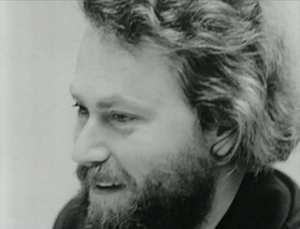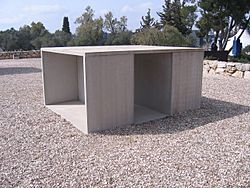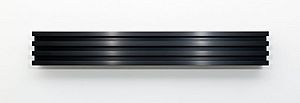Donald Judd facts for kids
Quick facts for kids
Donald Judd
|
|
|---|---|
 |
|
| Born |
Donald Clarence Judd
June 3, 1928 |
| Died | February 12, 1994 (aged 65) New York City, US
|
| Education | College of William and Mary, Columbia University School of General Studies, Art Students League of New York |
| Known for | Sculpture |
| Movement | Minimalism |
| Spouse(s) |
Julie Finch
(m. 1964; div. 1978) |
| Partner(s) | Lauretta Vinciarelli Marianne Stockebrand |
| Patron(s) | Dia Art Foundation |
Donald Clarence Judd (June 3, 1928 – February 12, 1994) was an American artist. He is known for his unique sculptures and ideas about art. Many people connect him with a style called minimalism. However, Judd himself didn't like that word. He wanted his art to be clear and strong. He believed that art should stand on its own, without trying to look like something else. Judd was also an important writer about art.
Contents
Early life and education
Donald Judd was born in Excelsior Springs, Missouri. He served in the Army from 1946 to 1947. After that, he went to college. He studied at the College of William and Mary. Later, he went to Columbia University School of General Studies. There, he earned a degree in philosophy. He also took art classes at the Art Students League of New York.
From 1959 to 1965, Judd wrote about art for big American magazines. In 1968, he bought a five-story building in New York City. He used this building as his home and art studio. Over 25 years, he fixed it up. He also put art he bought from other artists inside.
Work
Early art pieces
In the late 1940s, Donald Judd started as a painter. His first art show was in 1957. He showed paintings that were very expressive. By the early 1960s, Judd stopped painting. He started making three-dimensional art instead. He called these works "specific objects." He didn't want to call them sculptures. This was because they were not carved. Instead, they were made by factories using industrial methods.
By 1963, Judd had a clear style. He often made "stacks," "boxes," and "progressions." These were simple, repeated shapes. He used everyday materials like metals, plywood, concrete, and colored Plexiglas. He made his first stack in 1965. It was a series of identical iron units from floor to ceiling.
Judd often had others build his art based on his drawings. He believed that how art was made didn't matter. What mattered was the final artwork itself. In 1968, the Whitney Museum of American Art had a big show of his work. It only showed his later, three-dimensional pieces.
Judd bought his New York building in 1968. This allowed him to show his art in a more lasting way. He felt that art should be displayed permanently. He thought temporary shows didn't do the art justice. This idea became very important to him.
Later art pieces
In the early 1970s, Judd started visiting Baja California. He loved the quiet, open desert. This feeling for the land stayed with him. In 1971, he rented a house in Marfa, Texas. Later, he bought many buildings and a lot of land there. This area became known as Ayala de Chinati.
During this time, Judd's art became much bigger. He started making art that filled entire rooms. This made seeing his art a very physical experience. He believed art should not represent anything. It should just exist as it is. His art was clear, strong, and definite.
Judd began using unpainted plywood in the early 1970s. He liked it because it was strong. This allowed him to make even larger works. Later, in the 1980s, he used Cor-ten steel for big outdoor pieces. These steel works were made only in Marfa, Texas.
In 1984, Judd started using enamel on aluminum. He had a company in Switzerland make these pieces. This allowed him to use many more colors in his art. Before, his colors were limited. He used these new materials to make large floor pieces and wall works.
In 1990, Judd opened an art studio in Cologne, Germany. It was in an old liquor factory.
Prints and editions
Donald Judd also made many prints. He used different methods like aquatint and etching. But his main way was woodcut. He started making prints in 1951. At first, they were pictures of things. By the mid-1950s, they became abstract. In his prints, Judd explored the same ideas about shape and color as in his sculptures.
Between 1967 and 1992, Judd made eight different sets of art in editions. These were made from materials like stainless steel and wood.
Furniture and buildings
Judd also designed furniture and worked on buildings. He started designing furniture in 1970 for his New York home. When he moved to Marfa, he designed chairs, beds, and tables. He designed furniture because he couldn't find what he liked in stores. His early furniture was made from simple pine wood. Later, he worked with skilled craftspeople around the world.
Judd's work in architecture and furniture grew after 1978. He worked with Lauretta Vinciarelli, an architect. She lived and worked with him for about ten years. Her ideas influenced his designs.
When he passed away, Judd was working on fountains for a city in Switzerland. He was also designing a new glass front for a train station in Basel, Switzerland.
Today, a company in Switzerland still makes Judd's metal furniture. It comes in 21 colors. You can buy it through the Judd Foundation.
Chinati Foundation
In 1979, Donald Judd bought a large piece of desert land near Marfa. It included old buildings from a former U.S. Army fort. In 1986, the Chinati Foundation opened there. It is a non-profit art foundation. It is dedicated to Judd and other artists he admired.
The foundation has large artworks by Judd. It also has art by John Chamberlain and Dan Flavin. Judd's work at Chinati includes 15 outdoor concrete pieces. There are also 100 aluminum pieces. These are in two old army sheds. Judd carefully designed these sheds for his art.
Teaching and writing
Judd taught at several schools in the United States. These included Dartmouth College and Yale University. He also gave talks at universities in the US, Europe, and Asia. He spoke about art and how it relates to buildings.
During his life, Judd wrote many important essays about art. He strongly supported Minimalist Art. His writings were collected into books. His essay "Specific Objects," from 1965, is very important. It talks about new art ideas in the 1960s.
Exhibitions
Donald Judd's art has been shown in over 230 solo exhibitions. These were in museums and galleries around the world.
His first solo show was in 1957. In 1963, he had his first show of three-dimensional work. The Whitney Museum of American Art in New York held a big show of his work in 1968.
The Van Abbemuseum in the Netherlands had a show called Don Judd in 1970. This show traveled to other museums in Germany and London. In 1975, the National Gallery of Canada had a large exhibition of his work.
Judd showed his art at the Venice Biennale in 1980. He also participated in Documenta in Germany in 1982. Another big Judd exhibition was held in 1987. It traveled to museums in France, Spain, and Italy.
The Whitney Museum had another traveling show of his work in 1988. In 2004, a major show called Donald Judd was at Tate Modern in London. It also traveled to Germany and Switzerland.
More recently, a large show of Judd’s work opened at the Museum of Modern Art in New York in March 2020.
Awards
- Fellowship, John Simon Guggenheim Memorial Foundation, 1968.
- Skowhegan Medal for Sculpture from the Skowhegan School of Painting and Sculpture, Maine, 1987.
- Brandeis University Medal for Sculpture from Brandeis University, Waltham, Massachusetts, 1987.
- Frederick R. Weisman Art Foundation Award, 1991.
- Elected Foreign Member, Royal Swedish Academy of Fine Arts, 1992.
- Elected Member of the Littlefield Society, University of Texas, Austin, 1992.
- Sikkens Award from Sikkens Foundation, Sassenheim, Netherlands, 1993.
- Stankowski Prize from Stankowski Foundation, Stuttgart, Germany, 1993.
Museum collections

- Albright Knox Art Gallery, Buffalo, New York
- Art Gallery of New South Wales, Sydney, Australia
- Art Institute of Chicago, Illinois
- The Broad, Los Angeles
- Centre Pompidou, Paris
- The Chinati Foundation, Marfa, Texas
- Cleveland Museum of Arts, Cleveland, Ohio
- Cranbrook Art Museum
- Crystal Bridges Museum, Bentonville, Arkansas
- Dallas Museum of Art, Dallas, Texas
- Denver Art Museum, Denver, Colorado
- Des Moines Art Center, Des Moines, Iowa
- Detroit Institute of Arts, Detroit, Michigan
- Dia:Beacon, New York
- Governor Nelson A. Rockefeller Empire State Plaza Art Collection, Albany, NY;
- Migros Museum of Contemporary Art, Zurich
- Museum of Contemporary Art, Chicago
- Hallen für Neue Kunst Schaffhausen, Switzerland
- Hirshhorn Museum and Sculpture Garden, Washington.
- Indiana University Art Museum, Bloomington
- Israel Museum, Jerusalem
- Judd Foundation, New York/Texas
- Kunstmuseum Basel, Switzerland
- Kunstmuseum Bern, Switzerland
- Leeum, Samsung Museum of Art, Seoul, South Korea
- Los Angeles County Museum of Art
- Menil Collection, Houston, Texas
- Metropolitan Museum of Art, New York
- Milwaukee Art Museum, Wisconsin
- Moderna Museet, Stockholm, Sweden
- Mumok, Vienna, Austria
- Musée de Grenoble, France
- Museo Nacional Centro de Arte Reina Sofía, Madrid, Spain
- Museum Boijmans Van Beuningen, Netherlands
- Museum für Moderne Kunst, Frankfurt, Germany
- Museum Ludwig, Cologne, Germany
- Museum of Contemporary Art, Chicago, Illinois
- Museum of Fine Arts, Houston, Texas
- Museum of Modern Art, New York
- Museum of Modern Art, Shiga, Japan
- Museum Wiesbaden, Germany
- National Gallery of Art, Washington
- National Gallery of Australia
- National Museum of Modern Art, Tokyo, Japan
- Pinakothek der Moderne, Munich, Germany
- Royal Museums of Fine Arts of Belgium, Brussels
- Seattle Art Museum, Seattle, Washington
- San Francisco Museum of Modern Art
- Skulptur Projekte Münster, Germany
- Sprengel Museum, Hannover, Germany
- Storm King Art Center, Mountainville, New York
- Solomon R. Guggenheim Museum, New York
- Smithsonian American Art Museum
- Tate Modern and the Tate Britain, London
- Tehran Museum of Contemporary Art, Iran
- Van Abbemuseum, Eindhoven, Netherlands
- Virginia Museum of Fine Arts, Richmond, Virginia
- Walker Art Center, Minneapolis
- Western Washington University Public Sculpture Collection
- Whitney Museum of American Art, New York
Judd Foundation
The Judd Foundation was started in 1996. Donald Judd himself had the idea for it in 1977. Its main goal is to protect Judd's art and his art spaces. These spaces are in Marfa, Texas, and at 101 Spring Street in New York. The foundation keeps his homes, studios, libraries, and archives safe. These places are very important for understanding Judd's art.
The foundation also helps people learn more about Judd's art. It does this by letting people visit his spaces. It also creates educational programs.
In 2006, the Judd Foundation sold some artworks. This helped create a fund to support its work. The money helps keep his permanent art installations in New York City and Marfa, Texas.
In 2013, the Judd Foundation finished fixing up the 101 Spring Street building. It then opened it to the public for the first time. In 2018, they started a long-term plan to restore his buildings in Marfa. In 2022, eight of these buildings were added to the National Register of Historic Places. This means Judd's ideas about architecture and saving old buildings are now officially recognized as important.
The Judd Foundation also publishes books. These books are for students and anyone interested in Judd's life and art. They have reprinted his writings and published new collections of his notes and interviews.
Art market
Donald Judd's artworks are very valuable. His art has been shown and sold by famous galleries. These include the Leo Castelli Gallery and Paula Cooper Gallery. Today, his work is represented by Gagosian Gallery and Thaddaeus Ropac.
Prices for Judd's works have reached very high amounts. For example, in 2013, a large sculpture made of galvanized iron, aluminum, and wood sold for over $14 million. This shows how important and sought-after his art is.
Personal life
Donald Judd married Julie Finch in 1964. They had two children, Flavin Starbuck Judd and Rainer Yingling Judd. They divorced in 1978. Later, Judd was partners with artist and architect Lauretta Vinciarelli. In 1989, he met Marianne Stockebrand. She later became the director of the Chinati Foundation.
Judd had homes in New York City, Marfa, Texas, and Switzerland. He passed away in New York City on February 12, 1994. He died from a type of cancer called non-Hodgkin's lymphoma.
Images for kids
-
Untitled (1991), Israel Museum, Jerusalem
See also
 In Spanish: Donald Judd para niños
In Spanish: Donald Judd para niños




